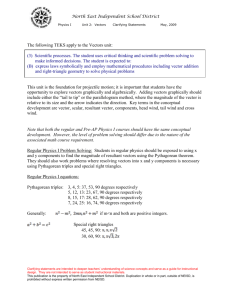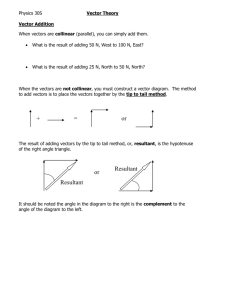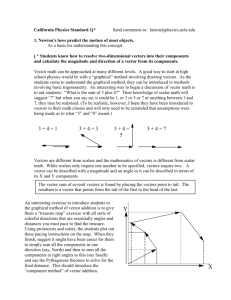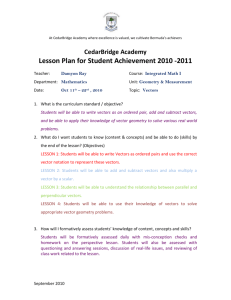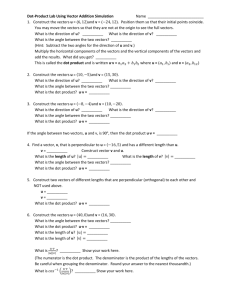Math 144 Activity #10 Applications of Vectors In the last activity, you
advertisement
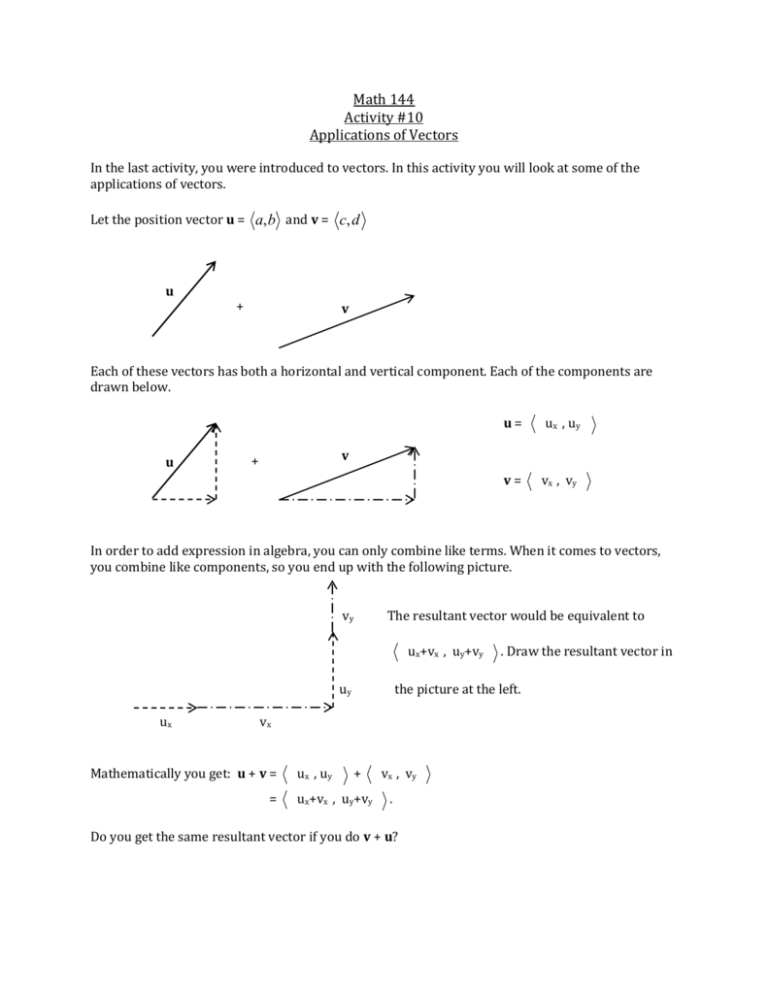
Math 144 Activity #10 Applications of Vectors In the last activity, you were introduced to vectors. In this activity you will look at some of the applications of vectors. Let the position vector u = a, b and v = c, d u + v Each of these vectors has both a horizontal and vertical component. Each of the components are drawn below. u u= ux , uy v= vx , vy v + In order to add expression in algebra, you can only combine like terms. When it comes to vectors, you combine like components, so you end up with the following picture. vy The resultant vector would be equivalent to ux+vx , uy+vy uy ux the picture at the left. vx Mathematically you get: u + v = = u x , uy . Draw the resultant vector in + ux+vx , uy+vy vx , vy . Do you get the same resultant vector if you do v + u? Find the resultant vector for v + w; then draw v, w, and v + w on the graph below. Label each of the vectors on the graph. v = 0,6 , w = 5,2 Now think about subtraction. Is this going to work in the same way? Try it with v = and u = u x , uy vx , vy . Find v – u. Start by explaining what – u represents. Find u – v. Is it the same as v – u? Explain your answer. Find the resultant vector for v – w, then draw v, w, – w and v – w on the graph below. Be sure to label each of the vectors on the graph. v = 1,3 , w = 4,5 Dot Product: Piece by Piece Let’s explore the idea of dot product. Like multiplying complex numbers, we want to see how each horizontal and vertical component interacts. To do this, let’s break down the vectors using pictures. u v + ux vx vy + uy vx + ux vy uy Since the middle two quantities each have a horizontal (x) and vertical (y) component involved, what should their values be? Explain your answer. Think about in terms of filling a bucket with water. If the bucket is held sideways (horizontally) under a stream of water flowing (vertically), how much water will end up in the bucket? The dot product should then be equal to the real number found by taking the sum of the corresponding component products, which is mathematically represented as the following: u v = ux vx + uy vy Find each of the following dot products. 1. p = 5,2 and q = 3,7 2. p = 3,6 and q = 2,5 3. p = 7 2 ,3 and q = 2 2 ,9 Dot product can also be calculated a second way. Consider the vectors in the diagram below, y If you apply the law of cosines to the triangle pictured, making sure to use the magnitude of each vector as the length of each side, you get u-v |u – v|2 = |u|2 + |v|2 -2|u| |v| cos v u x then using algebra and properties of vectors you will end up with u v = |u| |v| cos Using this formula for dot product will allow you to be able to find the value of the angle between the two vectors. Use this formula to find the angle between the vectors listed. 1. p = 5,2 and q = 3,7 2. p = 3,6 and q = 2,5 3. p = 7 2 ,3 and q = 2 2 ,9 Further Applications of vectors: What is work? To give a mathematical definition, the amount of work done is the component of force along a distance D times the distance the object is moved. This would give us a formula of W = |F| cos D. Now if the force is measured in pounds and distance is measured in feet, what are the units associated with work? Use what you have learned about vectors and work together as a group to answer the following questions. Draw pictures to show the action occurring in each problem. Be sure to include the correct units for each of your answers. 1. An old-time farmer is plowing his field with a mule. How much work does the mule do in plowing one length of a field 300 feet long, if it pulls the plow with a constant force of 250 lbs and the straps make a 300 angle with the horizontal. 2. As part of a “tough-man” contest, participants are required to pull a bus along a level street for 100 feet. If one contestant did 45,000 ft-lb of work to accomplish the task and the straps used made an angle of 50 with the street, find the tension in the strap during the pull. 3. A home owner applies a force of 40 N to push her lawn mower back and forth across the back yard. Find the amount of work done if the yard is 50 m long, requires 24 passes to get the lawn mowed, and the mower arm makes an angle of 390 with the level ground. 4. To break up the monotony of a long, hot, boring Saturday, a father decides to give his kids a ride in a wheelbarrow. He applies a force of 30 N to move the “load” 100 m, then stops to rest. Find the amount of work done if the wheel barrow makes an angle of 200 with level ground while in motion.

